Local Characters
People of Note
Varrick sisters. 1 Somerset Way was initially purchased by a solicitor called Shaw. It was sold to the Varrick sisters who were a music hall act – “Songs at the piano”. They were related to the noted Alfred Drayton who was a name appearing in the Ben Travers’ farces at the Aldwych Theatre, and he was a regular visitor.
Alfred King. Alfred King had been a music hall act doing animal impersonations before setting up as the Estate Agent in Richings Park.
Princess Victoria of Coppins, Iver. She attended functions at Richings such as the fete in the grounds of the Richings Mansion on Whit Monday 1928 and she was Patroness of the Richings Players.
Katherine More. Painter.
James Pilditch CBE. Grew up in Thorney Lane, author of “Can we stay up and watch the bombs” 1996.
Mrs Brum.
Revd David Brecknell
I was born in Richings Park in 1929. My late father had come here in 1926 when he qualified as a Chartered Accountant to work as Company Secretary for the Sykes brothers who developed Richings Park. He had completed his articles with the firm of Shaws in Dewsbury who were business associates of the development company set up by the Sykes brothers who were also from the Dewsbury area. After the company went bankrupt in 1931 he subsequently worked for successive receivers until 1938, when he moved to Tyson Chambers in Slough. My father bought 17 Wellesley Avenue, which was conveyed on 11/10/26. He was greatly involved in the local community that developed and was a keen member of the Cricket Club, both as a player and as an umpire.
I was 10 when the war started; throughout the war and after we could safely take a map and a pack of sarnies and roam the area on our bikes; cycle out to Watford to train-spot; ride through Stanwell (then market gardens) across Staines Moor and on through Ashford for a day out at Hampton Court. No-one had heard of Heathrow! During the war it became a hobby for my friends and me to spot new barrage balloons as they rose on evening exercise from their lorries. We would guess where they must be and set off on our bikes to see if we were right.
I recall a Latymer boy being billeted on us when his school was evacuated to Sough during the war and he and I having to take down the blackout and open the windows in the evening to clear the cigarette smoke before my parents returned from the Plaza cinema.
For quite a while we had an auxillary fireman – Mr Aurther Reeves – from Hawker’s billeted on us. He was a tough little middle aged man from Brixton, ex-Merchant Navy, Thames tugs and Sieman’s at Woolwich. He claimed that the best turn anyone had ever done for him was by the Magistrate in a juvenile Court, who had sent him onto a training ship. Mother received 7/6d a week from the Post Office to cover his costs. He proved very appreciative and a great amusing raconteur. He was also a dab had at finding things “lying about unwanted” which he thought would be useful round the house.
During air raids we slept on mattresses on the floor under the stairs as there was less risk of flying glass there.
For my parents, although not personally hurt, the war brought grief as their friends and friends’ sons were killed or imprisoned. As a result my father was very much involved with the Community Centre scheme and I can still remember him in August 1951 when I was back home from college in the ‘long vac’, depressed as could be, sitting at our dining room table working out the percentage interest due to each subscription from the invested capital and writing out the cheques in repayment. For most of a week he sat there after our evening meal, employed with the mechanics of what was, for him, a great disappointment.
I attended Richings Park School for Boys starting in 1935 and moved on to the Grammar School in Slough (in Lacelles Rd) in 1939.
6 June 1979
In 1925 the Ideal Home Exhibition had a model of Richings Park on display with the plots marked out, some houses built in Somerset Way, Wellesley Avenue, Old Slade Lane and North Park. There was to be a marine between Syke Ings and Syke Cluan where the gravel pits were and a recreation ground donated to the Estate by the three Sykes brothers who had bought the land, mostly turnip fields, from the two Meakin sisters – Lady Violet and Lady Charlotte Meakin, who owned Richings House, Old Slade Farm, Thorney and the surrounding area. Their two elder brothers had been killed in the Boer War. Advertisements appeared in the Underground in London – ‘Come to Richings Park and Walk on the Grass’. In fact it was a sea of mud, in common with most building sites. The water pipes were laid in a deep ditch where the paths now exist and the earth piled up where the verges are. You reached your house over planks. The ditches filled with water and the children had to be on reins. Two small children in Old Slade Lane, aged 3 and 2, were with a nursemaid and fell in. The nursemaid went to get help and sadly they drowned. Then the ditches were filled in. The Estate nearly lost the recreation ground as they had not put the legal once a year barrier up across the entrance. It was put up for the first time for sale by Friend Sykes who was short of money and wanted to marry Helen Burnett who had accompanied him from Yorkshire and lodged at 39 (or 49) Wellesley Avenue. The auction was to be in Liverpool and a resident went on the train with the Estate’s Deed of Ownership and we won the battle to keep it.
There were originally 15 types of houses on offer – you could modify the drawings – and there was a view across ploughed fields (shire horses) to Windsor Castle with nothing in between with fields of blue scabrous flowers. The Windsor Hunt went through the Estate at will, crushing plants and bushes and jumping the early fences. The hounds in full cry were very noisy and frightening. We got it banned after a few years. We were beset with gypsies selling pegs for several years. Houses were viewed and sold from a kiosk in the middle of the road in Wellesley Avenue by the newsagents.
Everyone worked in London and could see the signals at Langley and avoided waiting too long at Iver. This was a 20 minute first stop Iver service – 8.20am and return on the 5.40pm.
People came from Mansion Lane and Iver Village to work on the Estate and food came in vans from West Drayton and Uxbridge and milk from Richings House home farm with a cart, churn and dipper, drawn by Mary the horse. The Recreation Ground was rolled with a huge roller pulled by shire horses.
Richings House was fascinating. It consisted of a central block with a portico and two curved wing extensions on the sides. There was a huge Victorian conservatory on the right end where the Estate held their horticultural shows every year. There was a garden full of flowering bushes, a walk to a grotto past the 980AD St Leonards Chapel of Ease (Pilgrim route from Oxford to Canterbury – reference the Chief Archivist, St George’s Chapel, Windsor) now with the grass covered mounds where the walls were, marked on ancient monument maps. There was a ha-ha to keep the farm animals out, a Regency brick ice house and a complicated weir and pump house system for the river which had carried guests from their coaches on the Bath Road up to the house. The Halidon House school bus used to call in at the house to pick up two girls whose family lived in the Richings House, we waited by two large tulip trees by the front entrance. The house bedrooms all had a powder closet attached (used for powdering the wigs) a grand staircase and a ballroom – mostly bombed flat by a “bread basket” of bombs. The House was used as Bomber Command’s headquarters at the start of the Second World War whilst the huge HQ at High Wycombe was being built.
Captain Harry Haw (before the war)flew the Atlantic with great acclaim and bought the land from the Meakins to build hangars, offices and a large airfield,now covered by Langley houses. He formed Hawker Aircraft Ltd (later Hawker Siddeley) to manufacture and assemble fighter aircraft, at first the Hurricane and drew the staff from Kingston HQ and Brooklands Experimental Department, who were working on the Sop with Camel aircraft. I worked for the Chief Test Pilot for three months and then the General Manager until the end of the war. We worked through the raids, no warning just red flashing lights when enemy aircraft crossed the Channel, bliss when they stopped. We all had a medal for not going to the shelters. We were surrounded by barrage balloons to stop the dive bombing, and artificial black smoke stoves up the Richings Park roads on moonlit nights to provide cover. The sludge oil came from tramp steamers and smelt dreadful. Later the whole factory, aerodrome, offices and hangers were covered with camouflage netting and the windows blanked out all day. It operated 24 hours a day with shifts of 5000 people, all called up from Al Johnson’s wife to ballet dancers to University professors. Now we had a few women working on electrical systems for the planes and this increased.
‘Flying Fortresses’ and all the big bombers were flown in for repair by ATA pilots, mostly women, and I had the chance to take them to lunch, particularly Amy Johnson and Celia Thompson, two charming people. My one fear was that I should have to open a brown envelope stuck to the bottom of my desk containing “Authority to blow up and destroy all planes, hangers, offices and supplies if engines and fuel before they fell into enemy hands”. It was thought the men would be shot first if the Germans parachuted in. I didn’t think I could get away with it; thank goodness I never had to use the Authority from the Government. On VE Day, my boss and I burnt it.
This last item is included as Richings, Thorney and Sutton were formed the south of the Parish of Iver.
Although I was born in a nursing home in Tottenham, the first four years of my life were spent in an upstairs flat in Fairholt Road, Stoke Newington.
Memories of those years are inevitably indistinct – walks with my mother to either Clissold Park or Finsbury Park, both possessing a small aviary of pheasants and peacocks and the like, and one or the other some fallow deer, occasional contact with the landlord’s daughter, Joyce Strike, a few years older than myself; visits from various relatives, most of whom lived in Tottenham, office friends of my mother, and great Aunt Nance, a pillar of St Columba Haggerston, very high church, and smelling of something that was probably a mixture of incense and mothballs; Miss Benger, the local dressmaker, whose pin-trays I always upset; being taken to the cinema by my mother and a friend, a total disaster as I had to be removed screaming; a visit to my mother’s parents in Brecon, involving an endless train journey; a pedal car as a Christmas present in which I sat whilst my long-suffering father pushed me around the block, as I could not reach the pedals; and mysterious outings to places like Pinner, which involved a lot of walking and no interesting shop windows to look in. My parents were contemplating a move out of London. Four years of flat-dwelling in N.17 had proved enough and they had their eyes on owning their own house in what was beginning to be known as ‘Metro-land’, Pinner, Ruislip, Ickenham, Rickmansworth, where new estates were springing up all over the green fields of Middlesex.
I have no idea why my parents eventually chose Richings Park, ‘a model estate’ fifteen miles from Paddington and three miles inside Buckinghamshire at its southern extremity. Perhaps my father had seen it advertised in the ‘Morning Post’ which he read, not from political conviction, as he was a life-long liberal, but because its society columns were required reading for the secretary of a court florist’s firm Gerard et cie, in New Bond Street.
Richings Park was in the Parish of Iver, and the hamlet of Thorney, which I was to discover many years later was the site of a Viking encampment in the 9th century. The estate had been owned by the Bathurst family I n the 18th century and their mansion stood in acres of parkland with a home-farm adjacent.
The Estate had been acquired after the Great War by two brothers, Eric and Friend Sykes, who decided to transform some of the farmland outside the Park itself into a model housing estate. It was designed as a triangle. The apex touched the main GWR line from Paddington; on the east and south sides were existing country lanes and the west side was one of the estate roads. The interior of the triangle was to be a sports and recreation ground, which, according to a glossy brochure, was to contain tennis courts, cricket and hockey pitches, and a swimming pool. There was to be between two and three hundred houses. Sixty years after, thanks to Green Belt regulations, the estate retains it original layout, a garden city in miniature.
There was to be two parades of shops, a new railway station, and various other amenities, main drainage, electricity, street lighting, gravel soil etc. There were to be eight of nine different types of houses and bungalows, most on a quarter acre plot, or even larger in the case of the more expensive houses. The price range was about £500 to £1500.
My parents paid preliminary visits, by train to West Drayton, and thence by taxi, as the promised station had not yet been built, to spy out the land, and finally decided on an H type house- three bedroomed with lounge, hall, etc in what was to become Wellesley Avenue. They decided to call the house Woodberry, after the Woodbery Downs in Middlesex, where they had done their courting.
We moved in the summer of 1925. I have no recollection of the move itself. My earliest memories are of skylarks signing above the surrounding cornfields, looking out of a bedroom window at my mother’s directions to glimpse the Round Tower of Windsor Castle,just visible on the south west skyline, and the noise of trains. We were only half a mile from the railway, and the noise formed a constant background. The roar of the Cornish Riviera Express, belting along at sixty miles per hour; the interminable chugging and clanking of coal trains at night, fifty or more trucks drawn by a 2-8-0 Consol goods locomotive at under twenty miles an hour, and the constant noise of local trains at half-hourly intervals.
We could hear them leave Langley Station and time their arrival at Iver, almost to the second. I was kept awake by goods trains at night and terrified of expresses by day, especially as they thundered through Iver station as my mother and I waited for a train to Slough, our nearest shopping centre, or at that time the most accessible.
Later on I was to become a dedicated train-spotter and spent hours hanging over the station fence, jotting names and numbers down in a notebook and checking them against a GWR book of engines, Kings, Castles, Halls, Stars, Bulldogs, Moguls, Yonks and the inevitable 61 class 2-6-0 tanks that pulled the local trains.
We were among the first residents of Richings Park and watched the estate growing up around us, the building of houses, the gradual opening of shops; Keats the newsagents and tobacconists; Rees the Chemist; Blackman the Fishmonger; Nealing the Greengrocer; Napper the Cobbler. Some essentials had to come from outside the estate, Axell the Baker from Iver village a mile away; Rumble the Coal Merchant, who earned my mother’s undying gratitude by keeping the home fires burning with the odd hundredweight during the General Strike; Smith the Butcher from Yiewsley, Harman the Oilman from Slough, whose opening sales pitch was ‘Any soaps, sodas, matches or fire-lighters?’ a muffin and crumpet man came around complete with bell and tray balanced on his head. In the summer, the Walls Ice Cream man on his tricycle, who provided the residents with a card bearing a blue W to place in their windows should they require a Snofrute for 1d or a vanilla block for 2d, or go mad with a shilling strawberry and vanilla giant block. At Christmas, the Waits came up from West Drayton and played carols in the streets.
The Richings Park Sports Club gradually got under way and the tennis courts and cricket pitch became realities, but not the swimming pool. There was no village hall, but a hall with stage was added to the local pub, the Tower Arms, which became the venue for the newly forming organisations, the Townswomen’s Guild, much posher than the W.I. In Iver Village, a branch of the Women’s’ League of Health and Beauty, at which the housewives practised a primitive form of aerobics, and an amateur dramatic society, the Richings Players, whose first producer was Bill Mead, our next door neighbour, who persuaded my mother into appearing in bit parts in ‘Tilly of Bloomsbury’ and ‘The Sport of Kings’, their first two productions.
There was already a church. It had been built originally as a schoolroom for the children of Thorney by the Meeking family of Thorney House and had risen to be a chapel of ease of St Peter’s, Iver, known simply as Thorney Chapel. Later a Congregational church was to be built, but Baptists, Methodists and the like had to go to Iver Village and Roman Catholics to Langley or Slough.
The Vicar of Iver at the time of our arrival was the Revd. Mr Cobb. He began to visit his new parishioners on the estate on his bicycle. I was informed by my mother that the first time that he came to call, I left his tyres down. Soon we had a succession of curates, Mr Webb, Mr Pulford, Mr Thorpe, Mr Crowson, Mr Grey-Newton, who had a paralysed arm and rode a motor tricycle, Mr Mears, and Mr. Hines. For most of them it was a second curacy and they moved onto to preferment in a couple of years.
Thorney Chapel seated about fifty people. There was a full round of Sunday services in the Evangelical tradition, an altar cross but no candles, and the north-end position at the Communion. The music was provided by a harmonium played by Mrs Dennis, window of Archdeacon Dennis of the Niger, who was lost at sea during the Great War. She played the harmonium, trained the choir, run the junior Sunday School and rode everywhere on a tricycle, which she eventually gave to my mother when she herself became to infirm to ride it. She set my feet on the path to ordination, via Sunday School and choir, and when I was accepted for theological college, she passed on to me some of her husband’s books, stained with tropical use. She is surely among the saints.
I can remember by first winter in Richings Park, making the acquaintance of snow in bulk as I slipped and slithered, cold and miserable, as we walked around the lanes.
I began to make friends, Paul Mead from next door, Maurice Saunders, whose home was at the end of our garden, Dick and Allan Seal from the end of the avenue. There were some girls too, but they tended to be bossy and interfering, and were best left alone.
The question of my education now had to be considered. There was an elementary school in Iver Village, which my parents, influenced perhaps by the thought of their own school days in Tottenham, decided against. There was Richings Park school, a small preparatory day school run by one Captain Fenn in a large house in Richings Park, but this was judged to not quite the thing.
Finally on a personal recommendation, it was decided that I should attend the Limes School, a small mixed kindergarten in Iver Village run by Miss Bright. At the time of mu admission, rising numbers had prompted a move from a private house in the village to the ‘Church Institute’, next to the Parish Church. The pupils from Richings Park walked in a crocodile the mile to Iver Village led by Mabel Naesmith, Miss Bright’s unqualified assistant whose brother, Humphrey, became my friend and ally. The only uniform as far as boys were concerned was a brown school cap with an LS monogram in a shield. Here, I learned to sit still and listen, to read ‘the fat cat sat on the mat’, to write slowly and painfully on squared paper, to add and subtract, and to recite tables. All these academic pursuits mitigated by P.T. with dumb-bells, which made a very satisfying clunking noise, a little needlework – I made a kettle holder of which my mother was inordinately proud. We were told bible stories and were read to.
I can remember a book called ‘The Changeling’ which awoke an interest in nature-study. School was mornings only and we walked back in crocodile for lunch. I enjoyed the Limes, as I was biddable and eager to learn, and my only unpleasant memory was the abominable stench of the toilets in the Church Institute, which were calculated to give a sensitive child permanent constipation. No wonder my mother was always threatening the dreaded syrup of figs.
What of my father during these early years? He left the house at 8.15 each morning to catch the 8.27 to Paddington, and was at his desk in New Bond Street before 9.30am. The upper echelons of Richings Park society, the civil servants and stockbrokers caught the 9.04 am to be at work by 10am. He was usually back in the house before 7.30 pm – a long day. In the week before Christmas, he often used to sleep in the office.
When the Richings Park Residents’ Association was formed, Father joined and before long found himself in the office of secretary, which after ten years gained him a presentation electric clock. The Secretary was also the custodian of ‘the estate ladder’ much in demand from members decorating their houses, pruning their trees, or rescuing errant tennis balls from gutters. The great interest in my father’s life was his garden, which began as a quarter acre of former cornfield liberally decorated with brick-bats. Richings Park is in the middle of the Thames Valley gravel beds laid down in the Ice Age, and we were surrounded by gravel workings. By digging down about three feet, every resident could have his own gravel pit, very useful for gravel paths. It made for appalling stony soil which had to be raked and raked before any cultivation was possible. All father’s spare time was devoted to getting the garden into shape, with the occasional help of a jobbing gardener for a few hours a week. On an occasional Saturday morning, he would take a wheelbarrow, a good old fashioned wooden one, up to Slade Farm at the end of Old Slade Lane, and there pay Farmer Reeves a couple of bob for a barrow load of manure. I was allowed to ride on the barrow there, but obviously had to walk back. As a change, we would go into the park and come back with a barrow load of leaf mould. Eventually the garden took shape, vegetables at the bottom, some fruit trees, a summer house and a wooden swing. As far as I was concerned, the important feature was the lawn, twenty yards long and proportionately side, just right for cricket, which began to take a greater part of my spare time (and my father’s when he could be lured away from the vegetables to bowl to me) Most of the rows I got into concerned broken down plants and footprints on newly sown seedbeds, in pursuit of cricket balls.
Richings Park was beginning to take its final shape by about 1930. The two roads parallel to Wellesley Avenue were completed apart from a small worked-out gravel pit, which flooded and house a colony of newts. The Syke brothers, in an attempt to achieve immortality, named one Syke Ings and the other Syke Cluan. The names were supposed to have an Anglo-Saxon origin, but the residents considered them heuristic and daft and when a spur of Syke Cluan was named Syke Mains, before many months it was referred to as Syke Drains and before long was renamed St James. Two further closes at the end of Old Slade Lane became Poynings and Ridings, and that was that. Vacant plots in the other roads were built on, to the delight of boys who risked their necks exploring half-built houses. A very avant garde house with flat roof and sun trap windows in Wellesley Avenue was promptly named the Gaol, a name still used by the early settlers that remain.
Thorney Chapel was enlarged and provided with vestries, chairs instead of pews, and a small chamber organ. During the summer holidays, a group of theological students would descend on us for a ‘campaign’, special services, all manner of fun and games on the recreation ground, courtesy of the Sports Club, squashes and magic lantern shows, all of which helped to build up the lift of the Church, especially among the young people.
But other amenities were on the way. The formation of the LPTB led to a bus service to Uxbridge, and wonderful to relate, a cinema, the Plaza was built next to the station. It opened, I think, in 1931 or 1932 with an American version of Peter Pan and ran until 1939 when it became a furniture repository for bombed out or evacuated families. It never re-opened after the war, and was finally demolished to make room for a block of flats. The programmes changed twice a week, with matinees on Wednesday and Saturday. Occasionally a block-buster like King Kong or Lives of a Bengal Lancer ran for a whole week. Prices ran from 9d to 2/3d. There was a Compton organ, played by Doric Hawkswood, our church organist. The Manager, in a dinner jacket, greeted the patrons. There was a cafe upstairs which also served as a branch of the County Library, staffed by volunteers, and where the Roman Catholic heard mass on Sundays. The Plaza was not as posh as the Adelphi in Slough, let alone the Odeon, Regal or Savoy in Uxbridge, or even the Marlborough in Yiewsley, but it was our cinema and when it closed, all Richings Park grieved. In those years, homework permitting, my knowledge of the cinema was extensive and peculiar. Jack Hulbert, Will Hay, Astaire and Rogers, Deanna Durbin, with whom I fell madly in love at the age of sixteen, and a variety of Tarzans. I was not allowed to see Bela Lugosi as Dracula, to my great disgust, but managed to see Boris Karloff as Frankenstein. On Saturday morning there was a children’s’ matinee – Buck Jones and Tom Mix, lots of cartoons and an interminable aeronautical cliffhanger called Tail-spin Tommy. More sophisticated tastes saw Bette Davis, Norma Shearer, Charles Boyer and Ronald Coleman and a host of Hollywood luminaries.
The even tenor of my way was interrupted in September 1927 by the birth of sister Kathleen and the arrival at Woodberry of Tommy, an African grey parrot, banished from my father’s office for verbal hooliganism. He remained a feature of Richings Park life for the next forty years, as he sat in his cage in the front porch and exchanged the time of day with passers-by. He was greatly coveted by Mme Oda Slobodskaya, the soprano, a formidable Russian lady, who never failed to have a word with Tommy on her way to the station.
In 1929 I changed schools. There was plenty of choice of private schools for parents who didn’t fancy Iver Elementary, or the Tonman Mosely School in Slough, with the chance of a scholarship to a grammar school in Slough or Windsor. For the girls, there was Halidon House in Slough or St Bernard’s Convent in Langley. For the boys, Tower House in Slough or Windsor House were popular but my parents chose Uxbridge High School, later to become Frays College, where I stayed for the next nine years.
By this time, Richings Park school had changed both premises and headmaster, and was now runn by Mr W O Betts, known as Wob, and his sister. Miss Bright retired and the Limes was sold to Miss Kidwell who renamed the school, Linton House and moved it to Richings Park. My sister became a pupil there before going onto to Slough Girls Grammar School.
April 2009
My name is Marion Higgs (nee Levy) and I spent the first 25 years of my life (1945 – 1970) living at The Spinney, 21 Old Slade Lane, Richings Park. My parents and older brother continued to live there until the 1980s / early 1990s.
My parents, Daniel and Queenie Levy brought the plot of land in Old Slade Lane in 1938 and had The Spinney built to their own specification by the local builders, Thornton and Sons. The plot was about double the width it is now as my father rented a wide strip of land on the north side. The total garden covered about one acre. Until the 1990s The Spinney was the first house on the right hand side in Old Slade Lane. The first half of the Lane was woodland and was not built on until after my brother sold The Spinney in the early 90s.
The land behind the houses on the west side of Old Slade Lane and around The Spinney was farmland, owned by Farmer Reeves of Old Slade Farm. It was often grazed by cows which would sometimes break through the garden hedge and rampage through the garden causing much damage! The far side of the field was bounded by Main Drive which had originally led to Richings House. I understand that this farmland has now become a golf course. South of Old Slade Farm the Lane became more of a track which one could walk down as far as the A4 road. This was, of course, before the M4 was built.
The War Years
As I was born one week after the end of World War II, in August 1945, I do not have any personal recollection of the war years but learned a lot from my parents and brother. My father had been an Air Raid Warden in Richings Park and spent many nights on duty. Richings House had been requisitioned by the RAF and was guarded by Air Balloons which also surrounded the nearby Hawker Aircraft Factory at Langley. I believe a bomb was dropped on or near Richings House but failed to explode. We had a large air raid shelter in the garden (always referred to as the “dugout”) which served as an underground storage shed for years afterwards. Like most families, my parents supplemented food rations by growing all their own vegetables and fruit in the garden (there was an orchard of about 40 fruit trees) and by keeping chickens. I believe they also had a share in a pig which was kept at Old Slade Farm and there was always much exchange of produce between neighbours
Health and Education
Our local G.P. was Dr. Harding who resided and had his surgery in North Park.
He had no receptionist and when you needed to see the doctor you just turned up at the surgery and waited your turn. Should you require hospital treatment the only local choice was Upton Park Hospital in Slough. It was built on the site of the old Slough Workhouse and thought of as rather old fashioned and somewhat inadequate. (Wexham Park was not built until I was a teenager). If a serious operation was needed it was more usual to be referred to one of the big London teaching hospitals such as St Mary’s at Paddington or to The Canadian Red Cross Memorial Hospital at Cliveden.
Also in North Park was a private kindergarten school called Westfield, run by Mrs Davies. The uniform was blue, the badge (one of which I still have) had a golden oak tree on it with the motto “Ican, Ido”. I spent the first two years of my school life there, learning the basic three Rs in a little pre-fab schoolroom in the garden. We used to be taken for nature walks up Main Drive and through the Park. The choice of education beyond the nursery stage was the Council-run Iver School in Iver Village, and for girls, either St Bernard’s Convent in Slough or Halidon House School in Stoke Poges. I’m not sure where the boys went !
My parents sent me to Halidon House which I attended from the age of 6 to 18.
It was partially a boarding school but day girls would be picked up by motor coach at various stops in Richings Park, Iver Village and Iver Heath and transported to and from school. At the age of 12 we were supposed to stop travelling by coach and take the train to Slough, then a bus to Stoke Poges – a long and tedious journey. Fortunately, after a couple of years a larger coach was commissioned and we older girls could travel in comfort once again.
Shopping
In the 1950s it was possible to buy almost anything you needed in Richings Park apart from clothes and shoes. Most housewives would shop several times a week because, of course, there were no freezers and perishable food could not be stored for long. Also, many fewer housewives could drive, or had access to a car in the daytime to reach nearby towns. My mother would cycle up to the shops from Old Slade Lane 2 or 3 times a week. I remember most of the shops very well.
Starting at the top of Wellesley Avenue on the west side was a small garage called Richings Motors (I think it is still there). They carried out all the repairs on both my father’s Wolsley 14 and my brother’s Ford Prefect (and his many subsequent cars over the years!) Next to this was the United Dairies shop which sold all sorts of dairy produce e.g. milk, cheeses, butter, eggs etc. It always felt very cold in there as the floor and counters were made of marble.
Around the corner into Bathurst Walk and the first shop was a bakery run, for a few years, by Mr and Mrs Morrison. Their daughter Merlith came to my school. If you were heading for the station in the morning there would be the most delicious smell of freshly baked bread in the air. Sometime in late 50’s or 60’s the bakery closed and this shop became a branch library.
Further along Bathurst Walk was (I think) a hairdresser; a pharmacy with the traditional flasks of coloured water in the window; a butchers shop with sawdust on the floor and carcases hanging up; an off-licence run by Stowells and, at the Syke Ings end, the final shop was a fishmongers with an open frontage and the usual sloping marble slab displaying all the fish. The fishmonger really did wear a stripy apron and straw boater!.
At the top of Wellesley Avenue on the East side, opposite United Dairies, was my favourite shop – the sweet shop and newsagents. This was run by a Mr and Mrs Carroll when I was little. I remember they had a very large cat that sat on a pile of newspapers on the counter – it would growl and spit if you tried to stroke it! This was the shop that arranged local newspaper deliveries and the day my mother went to pay the paper bill was the day I spent my pennies on my weekly sweet ration or bought a small toy or comic (“Girl” comic was my favourite). Outside the shop was a notice board where you could advertise items for sale etc. On the two corners of Wellesley Avenue and Bathurst Walk were a Bank (Lloyds?) on one side and a Solicitors on the other.
Round the corner in Bathurst Walk, to the east, was one of the two grocers in Richings Park. This was Howard Roberts and it occupied two adjacent stores. The first was the grocery department – individual counters for cheese, ham and bacon (cut while you waited) and dry goods such a sugar in blue bags and biscuits bought by the pound from glass-topped boxes along the front of the counter. The second shop was the greengrocery dept. for all the fruit and vegetables. During my teenage years Howard Roberts was modernised and became more like a small supermarket. The two shops were knocked into one and customers helped themselves with baskets instead of queuing at each counter separately. There was a till next to the door. At the age of 16 (1961) my parents agreed to me finding a summer job in the school holidays and I found myself working as an assistant at Howard Roberts. Here I mostly packed boxes of orders taken over the phone for home delivery (long before online shopping!) and was occasionally set to work the till. I was very proud of my stiffly starched white coat and even more so of my very first weekly wage packet which worked out at 1/9d per hour! .(Howard Roberts was eventually taken over by Budgens)
The last shop before the area of open ground was an ironmongers with all the usual paraphernalia of dustbins, garden tools etc on the pavement outside. The best thing about the ironmongers was the wonderful smell of paraffin, paint and polish inside. Further along Bathurst Walk was a detached Tudor-fronted shop selling second-hand goods. My mother loved to mooch around this shop and often came home from there with “bargains”; I remembers items of china, an electric fire and a tea trolly all being transported home on her bike! I believe there was a service road that ran behind the above shops. I would ride my bicycle along this track to the rear entrance of Howard Roberts and I think it continued as far as the Second-hand shop where it joined another track to some houses behind the open area. I don’t know if it extended as far as Thorney Lane.
At the corner of Bathurst Walk and Thorney Lane was the imposing building of the Post Office and telephone exchange. To me it seemed a very large edifice with two pairs of double oak doors. It was here that all Post Office business was conducted and where I was taken each Saturday to buy 3 sixpenny savings stamps (with a photo of the curly-headed Princess Anne on them). The stamps were stuck in a small booklet and, when full, would be handed over and the grand sum of £1 entered in my Post Office Savings Account.
The other Grocer in Richings Park was Platts – the large Tudor-fronted shop near the station now occupied by a Natural History Bookseller. This was the store favoured by my mother and where we bought all our groceries. She found the staff more friendly there and was very sad when the shop closed. Further along this parade was a greengrocers and, at the far end overlooking the railway, Kings the Estate Agents. Opposite these shops, when I was very young, there was a cinema called (I think) The Ritz. It was closed before I was born but the building remained for some years until the site, and the adjacent open land were used on which to build flats.
Other Facilities
There was a sports ground off Wellesley Avenue where the local tennis and cricket clubs had their grounds. I cannot recall much about these clubs as I was a member of neither. But, at the top of the drive to the sports clubs on, the right, behind the gardens of houses in Wellesley Avenue, was a patch of land where the gardening club had its premises. This consisted of a disused railway goods wagon with double doors at the side. Every Sunday the ‘club’ would open for members to buy their various fertilizers and garden chemicals at reduced rates. I loved going down there with my father when he was ‘on duty’ and helping to weigh out bags of growmore, bonemeal and some strange black powder called ‘basic slag’ on huge scales for customers. How I wasn’t poisoned by running my hands though all these chemicals I do not know, but it was always an enjoyable morning and a change from playing in the garden at home.
Brownies and Girl Guide meetings were held at St Leonards Church in Richings Way (perhaps Cubs and Scouts also met there, but I ‘m not sure). Piano lessons could be taken with a French lady, Mrs Ray, who lived in Syke Cluan. I think there were dancing classes held at the Church Hall in Iver Village. I cannot remember there being a children’s play area in Richings Park. Perhaps this was because the majority of houses had large gardens and most children, like me, were very much kept at home to play or went to friends houses – perhaps there was not the need for a formal play area – or perhaps I was just not allowed out on my own to visit it.
Final Thoughts
I recently paid a nostalgic visit to Richings Park after a gap of some 35 years. My first impression was that not much had changed – most of the buildings I remembered were still there, a few gaps had been built on and the top of Old Slade Lane had houses where I had only known woodland. The most noticeable difference was the number of cars everywhere! I don’t recall cars being parked in the road outside houses at all – if one did have a car it was kept in the garage or drive, and it was very rare for a household to have two cars. There was never any difficulty parking outside the shops or for commuters to park in the potholed track alongside the railway station. I was especially concerned by the amount and speed of traffic along Richings Way and North Park. We never had any difficulty crossing the road between Old Slade Lane and Syke Ings but I imagine it must be quite dangerous now. However, I suppose this explosion in car ownership and traffic has happened everywhere and the quiet village-like atmosphere of places like Richings Park has, very sadly, gone for ever. I’m just glad that I spent my childhood and early adulthood in Richings Park as it used to be – it was idyllic.
My name is Raymond Smith and I now live in John Street, Rochester, Kent. I was born on the 30 October 1930 at No2 Home Farm cottages. My parents married in March 1929 and later they rented No2 (actually at that time 1 and 2 had been knocked into one).
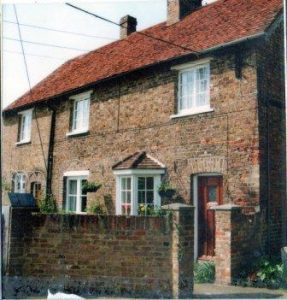
The terms of rental were that they would feed and care for any farm workers that needed accommodation. I remember two: Patrick O’Brien (sic) and Matthew Lawless both from the republic of Ireland. After the landmine that damaged Richings Lodge, and damaged our home, Patrick disappeared from my horizon. Mathew went to lodge with a workmate and friend of my father, the Clinkhards (sic), in Bathurst Walk.
I lived at the farm until c. 1940 after which my family had various lodgings in Richings Park. First at Himlea, Bathurst Walk and later at 2 Tower Cottages opposite the Tower Arms Pub (my Dad’s local). I was smuggled in the public bar, with the connivance of the then landlord.
In 1944 we moved from the area to Burnham. My father was an ex-cavalry man, 9th Lancers, and he used to be invited to “ride out” some of the horses with the then Master at the big house. My father worked at the Brittanic Cable co., north of the canal, with messrs Clinkard & Lawless. I remember Mr Goddard from the mansion, and I played with their son John; they moved to west Slough after the house closed. There was a water pump house halfway between the gates on the entrance road to the farm and the farm buildings themselves. The water was pumped to a big tank housed in the roof of the arched entrance to the complex.
Mr & Mrs (‘Grannie’) Nestling ran the walled garden and the produce went to Nestlings shop in Thorney Lane.
There was also a Cycle shop, which charged radio wet batteries, and a Chemist where I was treated for many minor injuries. A Miss Goodchild looked after the milking herd and lived with her mother in one of the cottages.
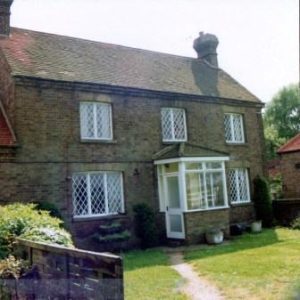
There was a chauffeur/carriage driver living in another cottage, who had two daughters and moved to the Birmingham area. There was one flat which was occupied by the farm manager (I think). The house we lived in had a black grape vine covering all of the south face, and we used to crop the grapes and make wine. I remember treading grapes. I sneaked off and drank some the wine on one occasion and got very drunk, but was alright after 24 hours’ sleep!! There was a communal clothes wash-house where all convened on Mondays and all helped each other with the laundry.
During the bombing of the Hawker airfield I remember both single aircraft attacks. One we were in the garden of the gatehouse to the farm entrance road when the bomber appeared out of the clouds and the anti-aircraft defences opened up. One large shell exploded right behind the aircraft’s tail, and we were told later the plane came down in the Staines area. My father suddenly realised about all the red hot shrapnel flying in every direction and hustled us all indoor of Mr & Mrs Bullock’s bungalow.
The second was during school time and all we could do was dive under our desks – I banged my head badly on desk top and seat doing so. There was one other bombing of Hawkers – it was during the early evening and it was dark.
It seems 42 bombs were dropped as I was told, what with the noise of the bombs and firing of the anti-aircraft guns on the train that ran to & fro on the main railway line. The train carried a range of guns from a large one down to machine guns.
We were having a social evening with the Clinkcards whose house backed onto the railway; they lived in Bathurst Walk almost opposite ‘Himlea’ where we were lodging at that time. It was the one occasion when I collapsed in terror.
Mr Cookson’s shop took all my sweet coupons; it was mind-bending deciding what to have as it was so little. I did thirteen paper rounds a week for the Churms newsagents in Station Approach and Saturday mornings I did greengrocery deliveries for the shop a couple shops along – I don’t remember its name. The other landmine to the one that fell in the ha-ha (they were always dropped in pairs) got hung up in the trees of Chestnut Avenue. We were all evacuated into the park while it was defused. Miss Goodchild’s Mother had lots of trouble getting there and a chair was taken out for her. It was defused successfully after the young naval rating, who had to make out his will, helped out the senior officer who was doing the defusing.
One further thing, sometime in 1942/43 the last two coaches of a London bound express caught fire and they uncoupled right outside the Iver signal box. I stood and watched them burn and the passengers walking to the other part of the train. They kept the other rail traffic moving on the slow lines, not something they would do these days! A picture of the burning coaches appeared on the next day Daily Express paper (I think it was the Express). Oh how I would love to have a copy of that photo.
Seeing in the memoires of one of your correspondents a reference to opera singer Oda Slobodskaya: I knew her as Mme Odette Sloboskaya or Mme Pelly. I think she was married to a Frenchman.
They lived in the first detached house in North Park beyond the main entrance to the drive to Richings Lodge going west. I know of Mme Odette because my Mother used to do domestic work for them – ‘charing’. My Mother would take me with her some days, school holidays etc. Whenever Mme Odette saw me she would throw her arms in the air and say ‘Ahhhhr Rrraymondd how are you?’. Being a lady of generous proportions and heavy makeup around the eyes made me very nervous and I would hide behind my Mother. Mme Odette would spend many hours in her music room singing up and down the scales.
Mum also did work for a family in Syke Ings – not sure which house – but in later years I used to go round with a greengrocer from a travelling family, Len Denning, who had a camp on Thorney Farm. He used a horse-drawn, round-topped, rubber-tyred van, and he would give me a trug with a selection of vegetables he had for sale. I remember going to the same house in Syke Ings, to the back door of course, but I was never recognized.
My parents belonged to the National Deposit Friendly Society and I guess they used that to pay for medical treatment. Our doctor was Dr Cousins from Iver village, and as a child I had great faith in her. I know my Mother had to have a kidney operation, my father a broken leg at work at the cable factory, and I had dental work at The King George V Hospital in Windsor.
Another family I remember from Home Farm was the Bucklands’ ‘Manager’. After closure they moved to a bungalow just off the A4 in Colnbrook. Like other people a Saturday highlight was to go to Slough shopping.
Our furniture was stored in the Plaza cinema until withdrawal in 1944.
[Information provided by Ted Aves, Audrey White’s son]
The attached photos belong to my mother, Audrey White, who was born in Richings Park in 1930.
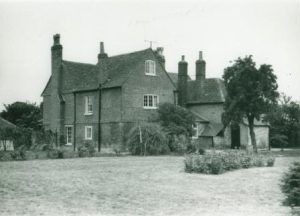
Her parents moved there in the late 1920’s, attracted by the easy travel into London and she lived in 38 Somerset Way, Syke Ings and then on Old Slade Lane.
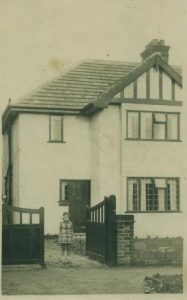
She married in1954 and bought 40 Somerset Way (where I was born) and we moved to Larbourne Farm in 1963 after she married Bill White, the only son of George White, who bought the farm in the 1931. We moved away from Richings Park in 1969. Bill knew the Sykes but I’m told that they didn’t get on.
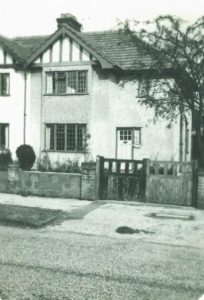
Mum still has very clear memories of her youth during and after the war years; the section where the burning of oil to mask the Hawker factory made me laugh as she had already told me how she could wake up covered in an oily black soot despite the entire house being locked up tight. Not sure people would be so tolerant these days!
She clearly remembers the Spitfire coming down but strongly recalls it as coming down in Syke Ings rather than Wellesley Avenue as she ran down to see it just after it happened.
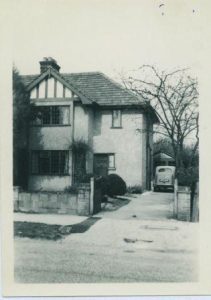
Photos are: Larbourne Farm, date unknown, but I would guess late ’50s, before Mr. White senior retired and moved away; 38 Somerset Way, approx. 1928/29; two pictures of 40 Somerset Way, the later one with the car taken in the ’50s (I would guess around 1955). I was born there in 1957.
I’ve included the Richings Players programmes as some of the names could ring bells with some people still at Richings Park:
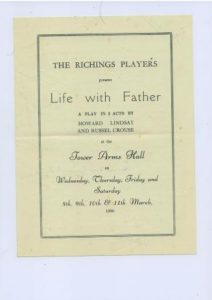
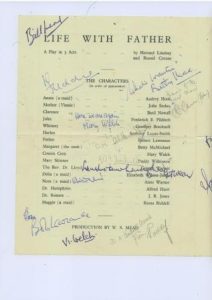
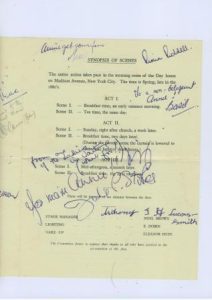
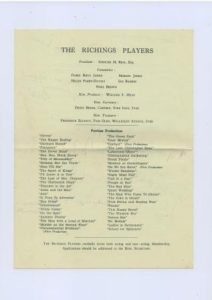
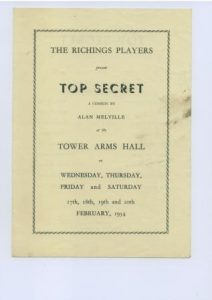
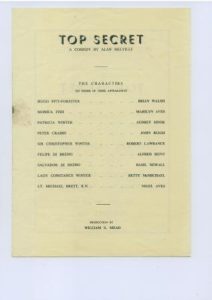
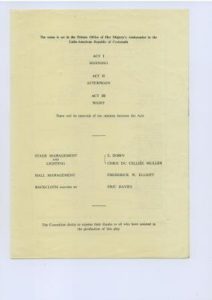
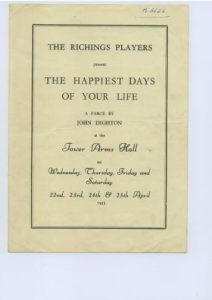
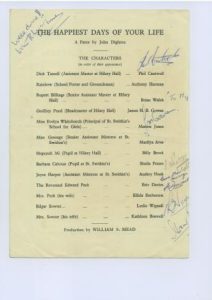
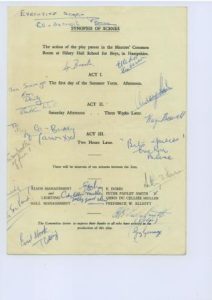
The Rankins and Richings Park

Malcolm Gray Rankin, my grandfather, retired from his job at the Tate & Lyle sugar refinery in Silvertown, North Woolwch in 1937 at the age of 69 and soon after made the move from his home in Shooters Hill, South Woolwich to Richings Park. He brought with him his wife Jessie aged 57 and his youngest son Ian David Malcolm aged 23 and they moved in to a house called Cranworth just opposite the Post Office in Bathurst Walk.
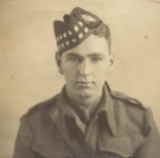
Soon after the marriage of their son Ian to Esme Bird in 1939, Malcolm and Jessie moved to a bungalow they called Dunrovin on the left hand side of Wellesley Avenue a few houses from the junction with Richings Way. Some time after that Ian’s brother James and his wife Freda with their daughter Wendy moved to another bungalow almost if not next door.
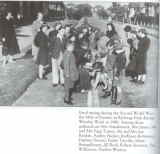
Family stories refer to a land mine falling nearby during the war and families being asked to move to The Tower Arms Hotel, something Malcolm Gray refused to do. It was said that James Rankin’s bungalow suffered some sort of damage during the war.
Malcolm Gray died 19th January 1944 whilst living at Dunrovin and soon after his widow Jessie moved to a flat, No7 Buckfield Court. At some time his son James and family moved away to Norwich.
These events must have happened before I moved to Roborough at the bottom of Wellesley Avenue in about 1946 as by that time Jessie and James had gone from the avenue.
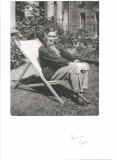
I am not aware that Malcolm did much within Richings Park in the short time he was there except he was a keen watcher of the cricket. Jessie on the other hand busied herself in the community one way or another and had a wide circle of friends till failing health necessitated her being moved to a care home near Purley, Surrey where her son Ian had moved to. This must have been about 1967 and she died in 1971.

Ian got involved with Richings Park life, firstly marrying a local girl Esme Bird then helping with the Gardening Club run out of an old railway wagon in the Sports Ground and joining The Richings Players, the Sports Club and The Masons. It was a community that sucked people into joining things and taking part. The cricketers would have a bowls match against the bowlers for example, to everyone’s amusement.
In his early days there, The Plaza Cinema was in use for dances as well as showing films and holding plays and shows but it did not survive and closed in 1940 but my father got involved with many of the events that took place there.
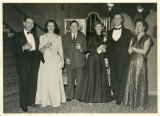
Like many others Ian worked in London and he and a group of other similars would travel up and down on the same trains the 7.54 up and the 5.40 back. He came home as regular as clockwork, there was none of the long hours of today. He also worked Saturday mornings and I was allowed to go with him and play with the huge, by today’s standards, calculating machines.
In 1952 Ian’s wife Esme died of cancer at the age of 38 in Taplow Hospital. She had been in and out of hospital for some time trying to beat the cancer but it finally took its hold.
After a while Ian got married again to another local girl Daphne Robins who shared his interest in The Richings Players and they played opposite each other in several productions. In the first months of their marriage they lived in his mother’s flat in Buckfield Court eventually moving to Iver Heath in about 1955.
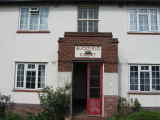
Despite living in Iver Heath, Ian kept up with the cricket club which I also joined and The Richings Players,as did Daphne and that remained the case till we moved to Kent in about 1959.
Growing up in Richings Park
My overriding impression of growing up in Richings Park was that it was a place where you knew everybody and you knew which houses they lived in and that it seemed as happy and safe a place to grow up in as you could wish for.
I was actually born in Windsor Hospital but I was the first birth the newly arrived Dr Harding was involved with from his practice in North Park, near the United Reform Church and near the site of the old Westfield House School. Before his arrival I believe Dr Cousins or Dr Saint looked after the estate from Iver or Langley.
I was the son of Ian Rankin and Esme, nee Bird.
The first years of my life were spent with my mother and her parents Randolph Bird and Mary nee Dixon, whilst my father was away in the war. Also in the house was my mother’s youngest sister Joy who I recall having a horse and a boyfriend Bill Winpenny, who had a motorbike and whom she later married and went north of Aberdeen, to be joined later by her parents. The Bird house was called Reema and was on the corner of Syke Cluan and Bathhurst Walk.
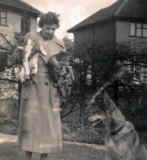
Being an only child in that household, I was somewhat spoilt, something my father wanted to put a stop to as soon as possible but it was a house full of fond memories, grandpa with an old cyclinder gramophone and a Jews Harp and lots going on. I remember hot fresh bread being collected for us all to tuck into, a chore done by grandpa.
Shortly after my father’s return home we moved nearly opposite onto the railway side of Bathurst Walk and not long after that into Roborough, the last house on the right at the Richings Way end of Wellesley Avenue. We rented there from Harold Radford who lived in Bath but would visit regularly to drop in at the Sports Club and go to Old Boy Dinners of his old school, Tonbridge in Kent. Just up from us were two bungalows, one called Dunrovin where my father’s parents lived and the other, name unknown to me, where my dad’s brother Jim Rankin and his wife Freda lived before he moved to Norwich. In 1944 my dad’s father died, whom I do not recall but who was tall and used to watch the cricket with a set of cronies and his widow, my gran, moved to Buckfield Court.
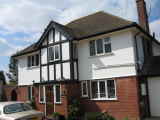
There were funny things I remember from Roborough like the times the old barrage balloon was put up, a reminder of the days in the war when they circled the area to protect the Hawkers factory near Langley and a passing Shooting Star US fighter plane. ITMA on the radio, an old wind up gramophone on which I liked playing 78s like The Old Bull and Bush, Workers Playtime on the radio and the arrival of The Eagle comic in 1950, the only comic I was allowed.
I had a lovely time there in that I had playmates on either side, The Rigby family on the right with sisters Christine and Katherine and brother Nicholas. To the left was the house St Boniface where the Wight family lived with son Gerald and daughter Susan. Father Wight was a television engineer pioneer so I had access to TV at a very young age (Muffin The Mule in a room with curtains drawn and a table lamp on). The Wight parents were stalwarts of the Tennis Club. I recall he had a big inflatable dinghy which got used as a mini bathing pool on the odd hot summer day.
When not in our gardens we went to explore in the park. On the corner of Old Slade Lane was a wooded section known to us as the first wood. It was quite small but notable for having a regular woodpecker nesting in a tall fir tree.
Moving futher into the park there was a field to the left that had a magnificent conker tree in it and in which there were held various fetes. Moving down what was the entrance drive to the RIchings Park Mansion, there was a group of about four houses to the right after which, on the right was a field where people like my neighbours The Rigbys grazed ponies.
The Mansion was half ruined and a bit spooky though the temptation to climb up the ditch on the south side to explore the old cellars was too much to resist till we got chased off. Behind the mansion was an off-shoot of the Grand Union Canal from it main route from West Drayton to Slough and beyond.
Just at the corner of the Mansion grounds by the canal was a broken bridge with no footway so the test was to get across on just the remaining framework. Also there was an old hollow tree which became a favourite camp. The canal led down and ended (except for a small overflow waterfall) to what was called the second wood, joined to the first wood by a long tree-lined avenue with a field famous for mushrooms on the Reeves Farm side. We had endless hours of fun playing so safely in those woods and also the Gravel Pits at the end of Old Slade Lane.
Memories of Roborough days include helping the United Dairies milkman Mr Dell do his milkround with his horse and cart later to be replaced with an electric cart, the window cleaners known to me as Hatch and Hales (perhaps their real names) and being called out to “Oi Snowball” as the workers cycled back and forth to the Hawkers Factory (I was very fair haired). I remember the US Air Force setting up a depot at the old airfield, which attracted some of the local girls to hang around near the fences chatting up these exotic vistors. Am I right to think I remember old Mr Anthony from Home Farm pushing a Penny Farthing around? Mr Dell’s round was big as he had to start from and return to his depot in West Drayton each day and I remember delivering to Mrs Jarvis at the few houses at the end of Old Slade Lane on the way to the Gravel Pits and past Reeve’s farm at one end and the gypsy camp in the field up by the railway beyond the last houses up Bathurst Walk overlooking the Hawkers Airfield at the other. It was the custom to offer Mr Dell a drink at Christmas and I think it was just as well that his horse knew the round and his way home!
Like others I remember the shops well which included a ladies hairdresser where my mother worked next to the bakers, Churms near the station famous for fresh made ice cream and Cooksons for sweets, later Carrolls and sited opposite the dairy shop, Blackmans the fishmongers with its big pike in a case behind the marble slab of a counter, a traditional butcher, Wilkinsons hardware store and Alfred Hunt’s upmarket grocery store at the other end of the row of shops from the offices of Alfred King, the estate agent and down from the greengrocers. I thinks it had been called Platts before Alfred Hunt took it over. I presume the Platts was the same group as the one at the top of the High Street in Iver. Rees the chemist was a good old fashioned chemists with big glass jars of coloured liquid in the window. Around there was Stowells off licence. Near the Post Office was a shop on its own called Hoeys which I would call a millners. In the area of the shops was Wilkinsons garage with its petrol pumps and from which Mr Wilkinson ran a taxi service using a big Ford Pilot, which my mother would sometimes use to take us to her sister Marjorie’s house in Swallow Lane, Iver (she had married Harold Chadwell of the old Iver Chadwell family of builders, decorators, funeral directors and bell ringers, the bell ringing at St Peters being watched over by the Reverend Cresswell). An important shop was Roberts the grocers which became one of the first supermarket style shops I can recall.
The Rigby family were great fun, I remember games of Mah Jong and trips to Windsor Great Park (The Copper Horse). With my parents I recall cycling to Black Park, trips to Boulters Lock at Maidenhead to help the lockmen and of course the sports club and The Richings Players. My father played hockey as goalie in the winter (I can still hear calls of “Come on The Park” from spectators) and cricket as wicket keeper in the summer and I used to help with the scoring at cricket. I went on to play cricket at the club till we moved to Kent in about 1959. It was one of the centres of Park life with it very active Bowls and Tennis sections and a great place to live backing onto.
My father in particular was keen on dramatics playing many parts over the years for the Richings Players under the guidance of Bill Mead. The Players were very lucky to have the expertise of two top Pinewood Studios make-up artists in the persons of Bob Lawrence and Basil Newall to call upon both of whom were excellent actors as well. An enduring memory of The Players was the role of Eddie Dobin as stage manager who changed a bare stage to some great sets with wires running everywhere which he somehow kept track of and clearing up on a Sunday morning after a show in which all took part
dismantling, breaking up and putting away what could be re-used in the garages at The Tower Arms pub run by Alf Brock and his family. In addition to the plays there were the annual Pantos in which all sorts took part, I think under the eye of Ethel Darsley amongst others and to the accompaniment of Minnie Robins on the piano (she was later to become my stepgrandmother).
Whilst at Roborough I joined the cubs with Anthony Lucas-Smith amongst others at the meetings held in the small huts behind St Leonards Hall. I later joined, briefly, the Scouts with scoutmaster Nigel(?) Reece. Whilst in the cubs I did my bit for Bob-a-Job, which the locals were happy to contribute to for their “job”, one I remember was weeding Mrs Robinson’s front path, she lived just up from us, under the watchful eye of her African Grey parrott, a very liked local feature. Talking of cubs and scouts, I remember a group of them going round with a cart collecting jumble and I can see the pretty, laughing face of Maureen Noble to this day.
After starting school at Westfield (fees £6 per term) I got moved to the village school in Iver to toughen me up. Westfield had a hut at the back in which things like the Christmas play were held and sports day was held in the back garden.
The only people I remember from Wesfield were Miss Overton, the headmistress and Ian Scott, with parents Ronald and Fay and brother Gordon. They lived at the Tower Arms of Somerset Way, on the right going down. Fay was something to do with dancing and Gordon was a very good cricketer. Some many years later my stepmother Daphne nee Robins was visiting Fay and she just did a small shudder and died as they were sitting chatting!
To get to the school in Iver I remember there was a school bus that a group of us caught at the corner of Syke Cluan and Richings Way. It must have been used for the return journey but I remember walking home at odd times.
I then went to Rutland House School in Hanwell which involved catching the 7.54 train, changing at West Drayton as it went on fast to Paddington to a more local train. Rutland House soon moved to Hillingdon which involved the same start to the journey but a 223 bus from West Drayton to Hillingdon Hospital and a good long walk to Hillingdon Church. There was gang of us doing this including Roger Birch, who had a sister Cherry-Ann, John Biddle who had a sister Christine and Timothy Berry. School ended at 4.45 and I recall the walk back in the dark to Hillingdon Hospital to catch the bus home. I can’t imagine that happening today.
The Biddle/Birch friendship covered endless games of football at the Rec’, (we always went “up the Rec'” never “down the Rec'”) and table tennis at Roger Birch’s. It was there that I watched Jim Laker get his 19 wickets against Australia in the 1956 Test.
In 1952 my mother Esme died and my dad and I went to live in his mother Jessie’s flat, No7 Buckfield Court. Whilst there, I grew up overlooking the railway from my Nan’s small patch of garden which she looked after closely. Not only was it on the main GWR line with its express trains like the Cornish Riviera but it also had coaling sidings and I would go to sleep to the noise of the shunting engine and the fusillade of clanging buffers as the trucks were manoeuvered about the tracks. The GWR was famous for its Castle, King and Britannia class engines, splendid machines and a trainspotter’s dream (I was one). The line also saw the short lived gas turbine trains numbers 18000 and 18100.
In the years before we moved to Iver Heath in about 1956 after my dad remarried (Daphne Robins), I recall cycling over many times to the picket fence and huts by the side of the A4 to see the planes in what was Heathrow Airport, a particular time being to go and see the giant Bristol Brabazon making a visit there, alas the last one as the plane was soon after scrapped as a white elephant.
At about this time I recall that the 459 bus started from The Tower Arms to Uxbridge in what I believe was a reopened service. It was poorly used but useful for getting to Uxbridge Open Air Swimming Pool when it was not closed for polio outbreak risks, an event that happened at some time every summer. It was a great place to go however.
Whilst living in Buckfield Court, I became friends with Tony Gilman and his parents who lived just by the Post Office in Bathurst Walk on the Post Office side. At the back of him was the Shawcraft factory and we used to go and watch the men making these amazing plane models used by airlines to promote their wares at exhibitions or just travel agents, humble beginning of what it developed into. I can recall the smell of the paint spray vividly. Tony and I would play endless games of cricket in the rec using the trees along the tennis court side as wickets up against houses of such as Bill Beck. Whilst we were doing that I remember Stephen Hyde and Martin Woodwood doing likewise with a very complicated game with no stumps and runs being decided on a judgement of where the ball went after being hit, how hard and its proximity to a field of imaginary fielders.
Martin lived in the house just to the left of the entrance to the sports club, with a father famous for going to work in a winged collar and looking very severe. Martin unfortunately died young. Steven lived in Bathurst Walk, near the Norridge family with whom I played yet more endless games of cricket.
My father insisted I help my Nan and I was not allowed out till 10.00am each day after having done the heavy shopping, which was fine by me but one job that was not such fun was taking shoes to be repaired to Mr Goff in West Drayton, which I did on my bike, dreading what I thought of as a steep hump backed bridge over the Colne by the mill. That area and the part of the park by the canal used to flood most years, the floods in the park being great when they froze over. 1947 was a very cold winter and not only did the floods freeze but also the canal. The snow allowed the making of giant snowballs on the sports ground by the likes of Nigel Aves and John Reece-Jones, people I regarded as gods being that much older than me and heroes of the sports club.
Just before I moved to Iver Heath, the Queen Elizabeth Terminal in the centre of Heathrow was opened accessed by a tunnel under the runways. This tunnel had two small tunnels on either side of the two dual carriageway tunnels and at the beginning, those tunnels were for cyclists and I remember regularly cycling through them for a day out at the central terminal.
In the promotion of Richings Park, much was made of the rail link at Iver Station and it certainly was a big feature for the lives of Richings Park folk acting as the way to go to work, shopping or travel generally. I used it to go to school by train where I remember the HMV factory by Hayes Station, the smell of coffee passing the Nescafe factory also at Hayes followed by the smell of oats from the Quaker Oats factory at Southall. Southhall also was the site of the big AE bus factory where you could see the finished buses lined up for distribution. The line into Slough gave access to the shops of Slough of which there were many but the journey took one past the Passold Ladybird brand of knitwear at Langley. Slough gave a link to Windsor which had the Theatre Royal for plays and pantomimes, Fullers for tea and Fullers Mints and for me the dentist Mr Talmadge in Praed Steet, down from The Castle.
There is a lot I have left out I am sure but I hope you can see that my early life in Richings Park was about as good as it could get, a community where so many people were able to help others like the team of volunteers who turned up to dig the trench in which to lay a new electricity cable for the new sports club pavilion, people like Mrs Coulter at the top of Somerset Way who would alter one’s clothes, etc etc, the list is endless like the names that come back to at randon, Jenkins with a giant poodle at the top of Wellesley Ave, Peggy Dobin, Richard Wells, Christine Biddle, Don Kenyon, John Moreton, Barry Budden, Derek Norman and family, Michael Brett, Norman Creek …….
My wife and I bought our first home at 10 Buckfield Court in around 1982.
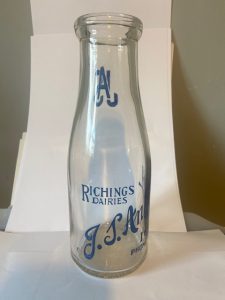 I found this beneath the floorboards of the flat and kept ever since.
I found this beneath the floorboards of the flat and kept ever since.
We were both teachers and earned some extra cash working behind the bar at the sports club. I remember one regular, aged maybe 40 at the time, who I believe lived in Thorney House, though I could be wrong.
We stayed in the flat for some 4 years. Bought for £23k, sold for £38k I believe. I was secretary of the Residents Association for a while and organised the repainting of the block, at a lower cost than the management company had proposed.
A very pleasant place to live even if we did feel a bit like poor relations to the owners of expensive neighbouring houses.